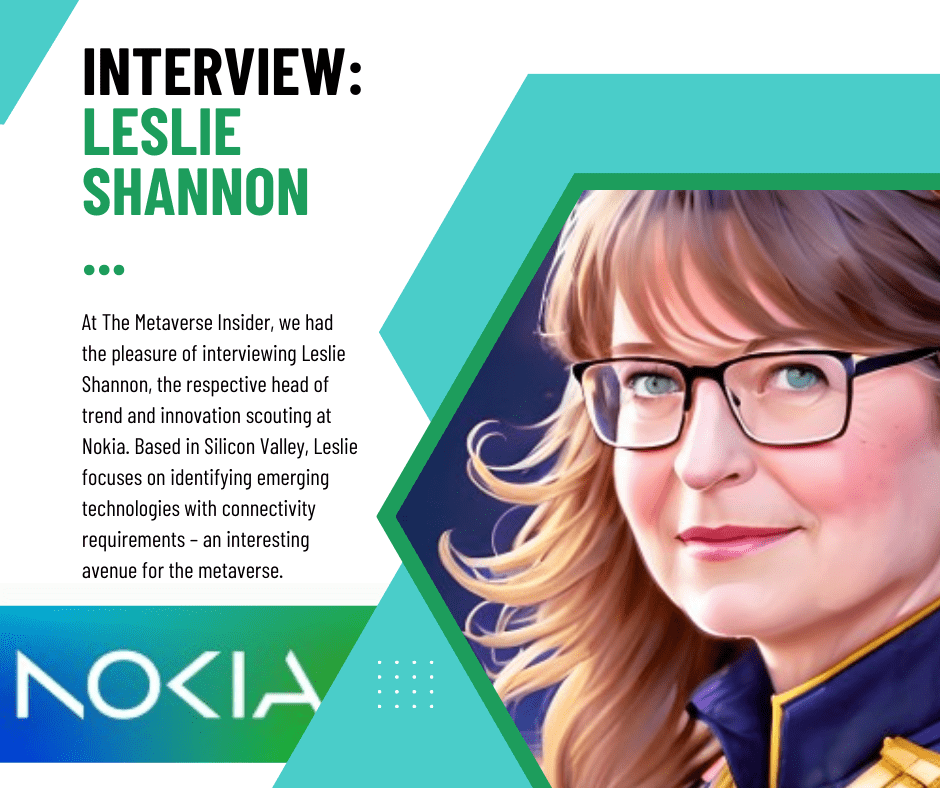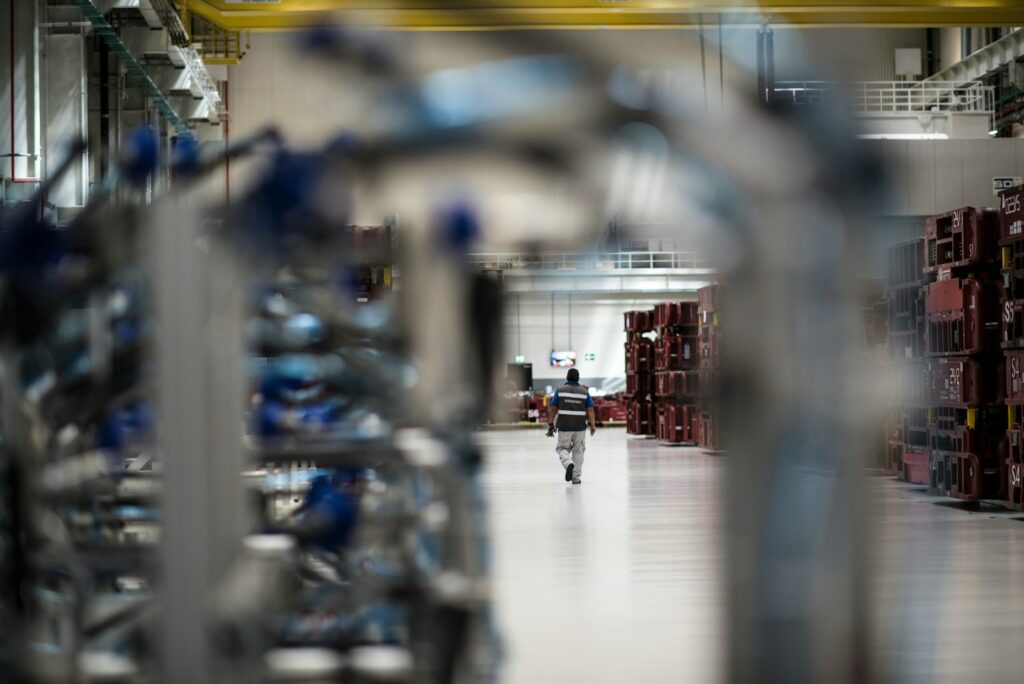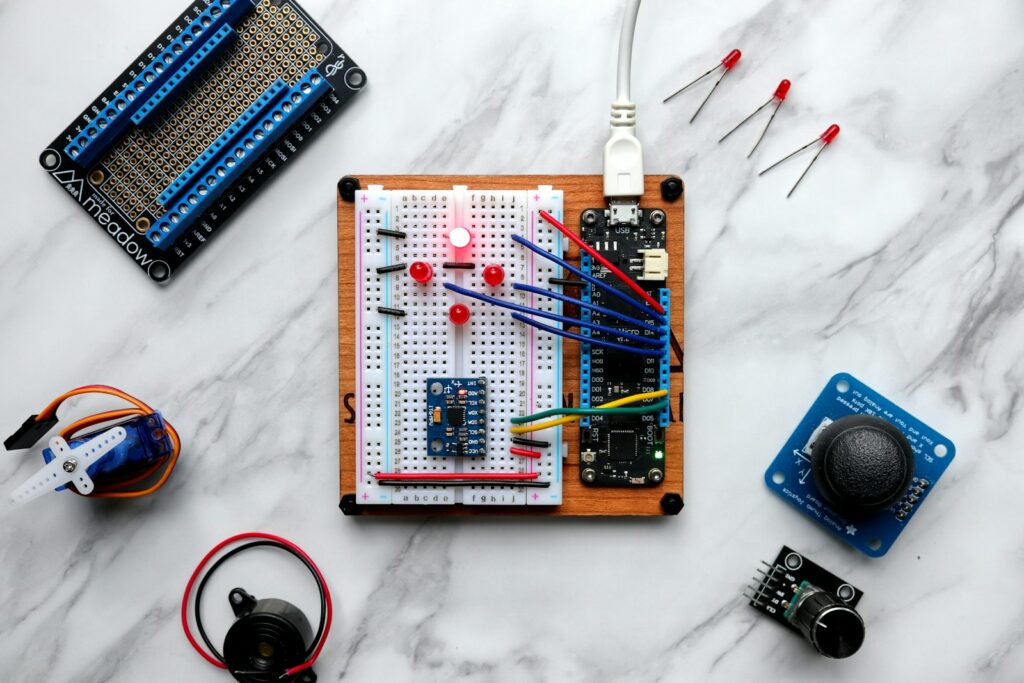At The Metaverse Insider, we had the pleasure of interviewing Leslie Shannon, the respective head of trend and innovation scouting at Nokia. Based in Silicon Valley, Leslie focuses on identifying emerging technologies with connectivity requirements – an interesting avenue for the metaverse.
Nokia, which no longer manufactures phones, now specializes in selling network equipment and services to phone companies and large enterprises. Leslie’s role involves informing Nokia and its customers about new technologies requiring connectivity and helping to build networks to meet those needs. She has been exploring augmented reality, virtual reality, and visual analytics for the past five to six years, making her well-versed in metaverse initiatives.
The union of the digital and physical worlds
Leslie discusses the current state and future potential of the metaverse. They emphasize that while some aspects of the metaverse already exist, like avatars and three-dimensional digital worlds in platforms like Rec Room and VR Chat, people are unlikely to spend their entire lives in such digital environments. The physical world remains important, and the true potential of the metaverse resides in the integration of both worlds:
“For me and for Nokia, the true promise of the metaverse lies much more in the union of the digital with the physical.”
It is made clear by Leslie that there are three types of metaverses: industrial, enterprise, and consumer. Industrial and enterprise metaverses are currently in use, but the consumer metaverse is still emerging. The key missing element for realizing the consumer metaverse is a practical, comfortable, and widely accessible consumer augmented reality (AR) headset.
Creating such a headset will require advancements in several areas, including:
- Optics: Improved visual quality and the ability to render realistic and immersive digital content.
- Battery technology: Longer lasting and more efficient batteries to support extended use.
- Computation: Shifting the computational load from the headset to the network enables lighter and less bulky devices.
Generative AI is expected to play a significant role in realizing the full potential of the consumer metaverse. With a slim form-factor AR headset connected to powerful computational resources in the network, generative AI will enable users to create and interact with digital content in entirely new ways. Leslie envisions a future where users can “speak into existence” any type of digital content or programming they can imagine, enabled by a strong, low-latency connection between the headset and the network.
Is the Metaverse beyond Wi-Fi connectivity?
Currently, many metaverse experiences run on Wi-Fi, which people often take for granted. However, Wi-Fi relies on a landline connection to function, and poor connectivity can lead to latency issues and negative user experiences, such as nausea in VR headsets. The speaker emphasizes the need for improved Wi-Fi quality and better landline connections, like laying more fiber instead of copper, to enhance the consumer metaverse experience:
“How we make the consumer Metaverse experience a really good one is actually by improving the quality of our Wi-Fi.”
Leslie also highlights the limitations of Wi-Fi in enterprise and industrial metaverse settings. For applications requiring mobility and immediate response, such as teleoperations or large data feeds from 360-degree cameras, Wi-Fi is insufficient. In these cases, 5G is necessary due to its higher bandwidth, lower latency, and increased security compared to Wi-Fi:
“In cases of teleoperation, or if you need security, Wi-Fi as bandwidth is pretty open. People can sneak and listen to what it is that you’re doing. But 5g is not. So, if you want to make sure that what you’re doing is completely unhackable, you want to use 5g for that.”
The significance of HPC cloud computing for the Metaverse
Due to the constraints of physics, such as the speed of light, low-latency communication (around 10 milliseconds) requires computing resources to be located relatively close – approximately 15 kilometers to the end device. However, distributing data centers in this manner is expensive.
To understand how far processing can be moved from the device to the network, R&D efforts are focusing on different use cases. Enterprise and industrial settings, with their fixed footprints and on-site servers, provide controlled environments for experimentation. These setups act as dress rehearsals for implementing similar functionality on a larger scale for consumer networks:
“How do we build these networks at scale? One of the reasons why enterprise and industrial [Metaverse initiatives] are so important right now is because it lets us experiment.”
Leslie acknowledges the challenges of providing such computing capabilities in the network but believes the potential benefits of these devices make it worth pursuing:
“It’s going to be a heavy lift to be able to provide that kind of computing in the network. But the promise of what was going to be possible if we can build these devices is so gigantic, that it’s absolutely worth going for.”
Nokia’s current projects in enterprise and industrial Metaverse initiatives
Nokia is particularly interested in improving 5G and developing 6G, working closely with other companies like Qualcomm to set the standards for these technologies:
“We are one of the main companies along with other companies like Qualcomm, who were working in the standards bodies to set the standards for 6G.”
Regarding 5G, Leslie explains that it was designed with a large downlink capacity to accommodate the explosion of streaming traffic from services like Netflix and YouTube. However, the uplink capacity (from user devices to the network) is much smaller, causing issues for user-generated content and 3D scanning that require sending data back to the cloud. This problem will be addressed with 5G advanced, set to be available in 2027, by increasing the uplink channel’s capacity:
“So that’s actually part of the R&D that’s going on right now. What are the use cases where you can take the processing off of the device and put it on the network? And how far away can it go?”
The company is also working on setting the standards for 6G, anticipating the needs of the metaverse and how it will evolve. This process involves a deep understanding of the metaverse’s underlying infrastructure and the aspects that need to change to accommodate its future growth:
“We are looking hard at the underpinnings of the metaverse to understand what aspects of it…what areas of the network are going to get pushed on? What things need to change from today?”
Nokia has a massive emphasis on the blending of physical and digital worlds, focusing on how the network can handle this convergence. Another important aspect is human augmentation, which includes AI-powered body enhancements and potential brain implants like the Neuralink. The company is examining the connectivity requirements for these innovations and ensuring that the technologies developed are safe, particularly when they involve devices that are in close proximity to human skin, like smartwatches or potential brain implants.
Nokia continues to uphold its motto of “connecting people”, albeit in an entirely different manner from its initial beginnings. Transitioning from mobile phones to the metaverse, Nokia is proving to be a trailblazer in providing the necessary infrastructure for the internet’s ongoing evolution.

















